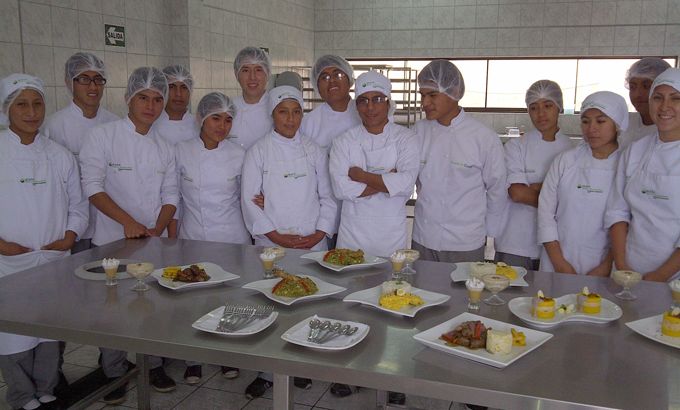Cooking school lights up Peruvian shantytown
Institute gives poor youth a shot at their dreams as cuisine increasingly becomes a point of national pride.

There was an explosion.
A ball of fire rose from under the heavy, rugged wok as the cook carefully folded and charred the tenderloin cubes.
Keep reading
list of 4 itemsUS imposes new sanctions on Iran after attack on Israel
A flash flood and a quiet sale highlight India’s Sikkim’s hydro problems
Why is Germany maintaining economic ties with China?
As the flames grew, the air became perfumed with the scent of soy sauce, vinegar and chillies – a mix of creole and Chinese flavours that make up one of Peru’s darling dishes: lomo saltado, or sauteed beef.
Peruvians have become “enfants terribles” when it comes to food, and boast of having one of the world’s best cuisines. And if the dish is not perfect, they’ll say it.
Luis Cordova, a 20-year-old aspiring chef, knows this. He says he has finally learnt the ideal balance for the rice and chicken dish in “the traditional way, with yellow chillies, cilantro paste and a little bit of garlic”.
Institute for the poor
Cordova is learning his art at a special school established when the world’s growing love for “haute cuisine” reached a remote corner on a hillside of one of Lima’s shantytowns.
With the help of Peru’s most renowned chef, Gaston Acurio, and a Catholic trust, a local priest of the district of Ventanilla began a small brick construction project in a desert area five years ago that would eventually become the Pachacutec Culinary Institute.
The institute is now a magnet for 16- to 24-year-olds, who all have at least one thing in common: poverty.
Because Peruvian cuisine has become a matter of national pride, youngsters who once dreamt of becoming football stars now want to follow in Acurio’s footsteps and become celebrity chefs.
|
“We want them to be disciplined, to be humble, to learn team work, to be cooperative.” – Rocio Heredia, the director of Pachacutec Culinary Institute |
Many young men and women from around the country will do anything to study here.
Luisa Pumacaya gets up at three in the morning and travels four hours, including walking a few kilometres in the desert, to reach the academy. There is no public transportation all the way to the academy, but “it’s totally worth it”, she says.
Seventeen-year-old Jennifer Palacios moved from northern Peru to the capital to give it a try, even though she was unsure she would be one of the 40 selected of the 500 students that apply every year.
The institute is a small building, and inside there isn’t space: one big kitchen with several stoves, a few counters and some cooking tools is all that fits.
The students are divided into groups to learn cooking theory, math and other classes.
The place is vibrant. Men and women take turns carrying huge water cauldrons, chopping onions, or stirring the juices of sweet strawberries.
They analyse the dishes, while they explore different ways of decorating them, whether it may be a traditional dish or a new one.
The walk around this kitchen is overwhelmed with the smell of fresh herbs, boiling apples, or cilantro and garlic pastes.
Passion and values
Director Rocio Heredia says the school wants to give the students much more than just the credentials to be a top chef.
Aside from learning good techniques, balanced flavours and the careful presentation of each plate, they also learn values.
“We want them to be disciplined, to be humble, to learn team work, to be co-operative.” Heredia says many of these students have never been told they’ve done something right, and many of them don’t value themselves.
|
“This is my dream, and I am going towards it. The world is mine, but I just have to win it.” – Jennifer Palacios, a student |
Pumacaya, for one, says she’s never felt as fulfilled as now.
“Every day I get up and think it is a challenge. It makes me happy,” she said.
Heredia says the only prerequisite for applying is passion. “We want to keep the culinary flame lit inside of them,” she said. “Once they’re in, they only have to pay around $40 per month. Everything from tools, groceries to books are donated.”
Every now and then, a world-renowned chef shows up here to teach a class – including Catalan chef Ferran Adria, owner of El Bulli, which was arguably once the most famous restaurant in the world.
And the school helps find its students jobs when they graduate. One hundred graduates are already cooking in some of Peru’s best restaurants, while others have won scholarships to learn directly from European masters.
Palacios smiles as she slowly stirs her aji de gallina, another classic Peruvian dish. “This is my dream, and I am going towards it. The world is mine, but I just have to win it.”